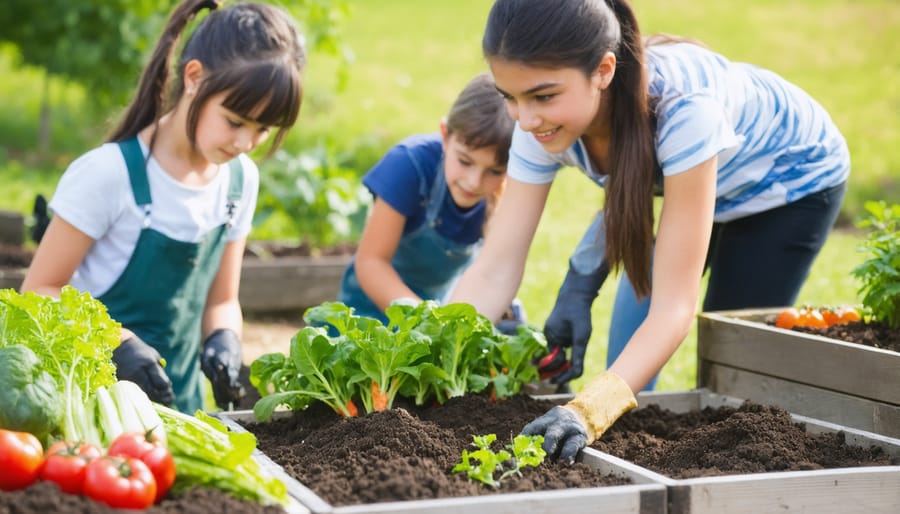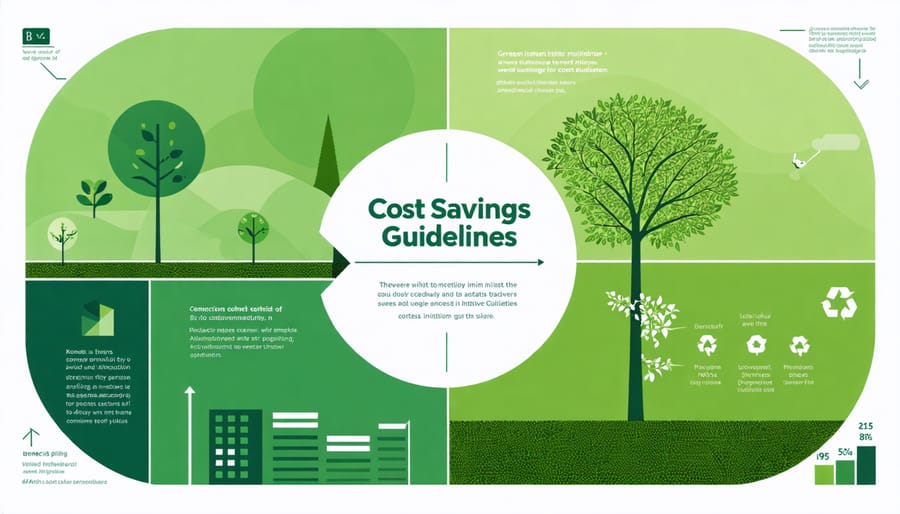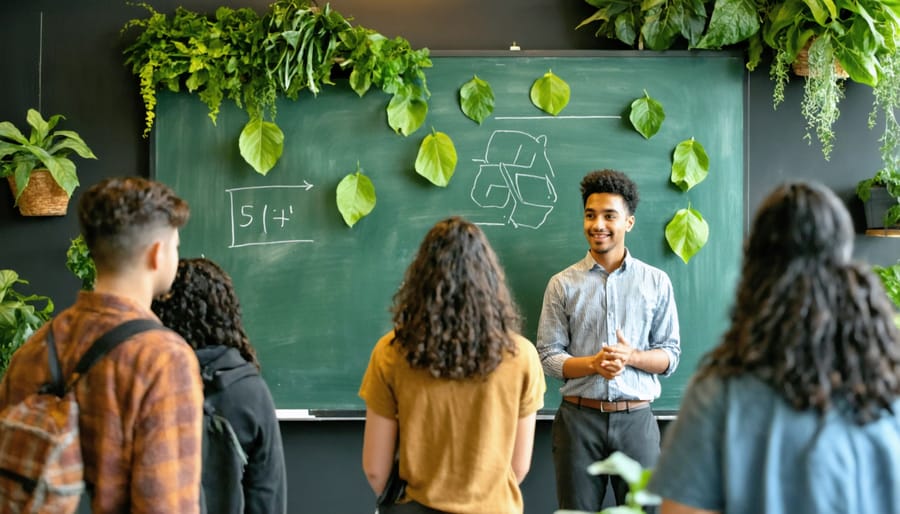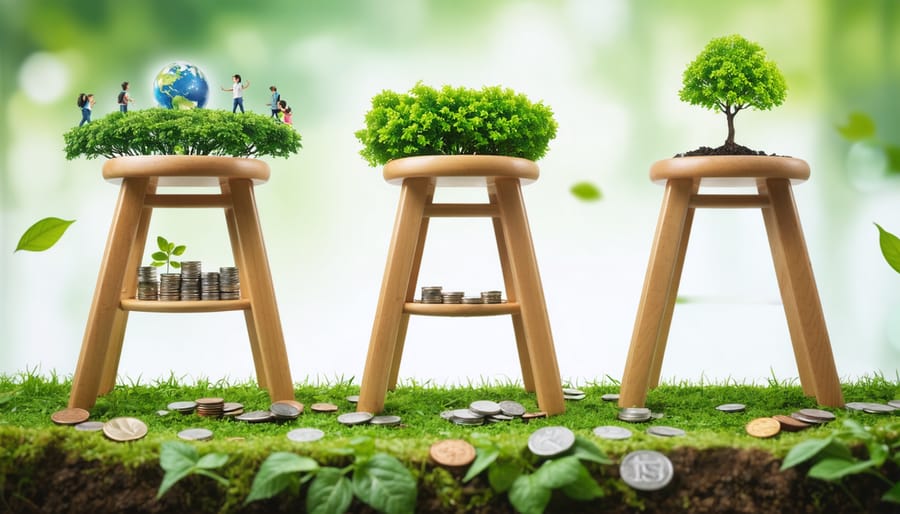Sustainability stands on three fundamental pillars that work together like a well-orchestrated symphony. Through sustainability education that works, we’ve learned that environmental stewardship, economic viability, and social equity form the foundation of a truly sustainable future. These components aren’t just theoretical concepts—they’re practical frameworks that drive real-world solutions.
Picture a three-legged stool: remove any leg, and the entire structure becomes unstable. Environmental sustainability protects our natural resources and ecosystems, economic sustainability ensures financial viability without compromising future generations, and social sustainability maintains community wellbeing and equal opportunity. Together, these elements create a balanced approach that addresses our present needs while safeguarding tomorrow’s resources.
In Australia’s rapidly evolving landscape, understanding these three components isn’t just academic—it’s essential for building resilient communities, developing sustainable businesses, and creating lasting positive change. Let’s explore how these pillars work together to create a more sustainable future for all.
Environmental Sustainability in Schools
Resource Conservation Programs
Schools can implement effective resource conservation programs through a combination of practical initiatives and student engagement. Waste reduction starts with comprehensive recycling systems, including clearly labeled bins for different materials and composting programs for cafeteria waste. Many Australian schools have successfully reduced their waste by up to 70% through these measures, coupled with ‘nude food’ policies that encourage package-free lunches.
Energy efficiency improvements begin with simple changes like switching to LED lighting and installing motion sensors in less-frequented areas. Solar panels on school rooftops not only reduce electricity costs but serve as valuable teaching tools for students learning about renewable energy. Schools can track their energy usage through smart meters, making it easier to identify areas for improvement and demonstrate success to the community.
Water conservation efforts should include both infrastructure updates and behavioral changes. Installing water-efficient fixtures, harvesting rainwater for gardens, and maintaining drought-resistant native plants can significantly reduce water consumption. Student-led water monitoring programs help spot leaks early while teaching valuable conservation habits. Brisbane schools implementing these measures have reported water savings of up to 45% annually.
To maximize impact, these programs should involve the entire school community, with students taking leadership roles in monitoring and promoting conservation efforts.
Biodiversity and Green Spaces
School gardens and green spaces serve as living laboratories that bring sustainability education to life. By creating dedicated outdoor learning environments, schools can foster a deep connection between students and nature while promoting biodiversity. These spaces become thriving ecosystems where native plants provide habitat for local wildlife, including birds, insects, and small mammals.
Gardens offer hands-on opportunities for students to learn about food production, plant life cycles, and ecological relationships. When students cultivate vegetables and herbs, they gain practical understanding of sustainable agriculture and food security. Native plant areas showcase Australia’s unique flora while teaching important lessons about water conservation and climate-appropriate landscaping.
These green spaces deliver multiple benefits beyond environmental education. They create peaceful areas for reflection and relaxation, supporting student wellbeing and mental health. The gardens can also supply fresh produce for school kitchens, reducing food miles and demonstrating closed-loop systems in action.
Successful implementation involves careful planning and community engagement. Schools can partner with local environmental groups, indigenous knowledge holders, and horticultural experts to design spaces that are both educational and sustainable. Regular maintenance becomes part of the learning experience, with students taking responsibility for garden care through structured programs and activities.

Economic Sustainability Integration
Budget-Smart Green Initiatives
Implementing sustainable practices doesn’t always require massive investments. Smart budgeting and strategic planning can lead to significant environmental impacts while delivering substantial cost savings over time. Leading the way are initiatives like LED lighting retrofits, which typically pay for themselves within two years through reduced energy bills. Similarly, installing water-efficient fixtures and implementing simple recycling programs can dramatically cut operational costs.
Many Australian organisations have found success with low-cost sustainability measures. For instance, implementing paperless systems not only reduces waste but also streamlines operations. Installing sensor-based lighting and programmable thermostats offers another budget-friendly approach to reducing energy consumption. These small changes often lead to impressive annual savings while shrinking the carbon footprint.
Perhaps the most cost-effective green initiative is employee education and engagement. Creating a culture of sustainability through training programs and incentives can lead to behavioural changes that generate lasting impact. Simple actions like encouraging reusable containers, promoting carpooling, and establishing green procurement policies require minimal investment while yielding significant returns.
The key to budget-smart sustainability lies in prioritising projects with quick payback periods and measuring outcomes effectively. This approach ensures continuous improvement while maintaining financial viability, making sustainability accessible to organisations of all sizes.

Future-Ready Skills Development
In today’s rapidly evolving job market, preparing students for sustainability-focused careers is crucial. By developing future-ready skills, students can position themselves at the forefront of the green economy. Schools are increasingly incorporating hands-on learning experiences that simulate real-world sustainability challenges, from designing energy-efficient buildings to managing renewable energy projects.
Students learn valuable skills through practical activities like conducting energy audits, developing waste reduction strategies, and creating sustainable business plans. These experiences not only build technical knowledge but also foster critical thinking and problem-solving abilities essential for green jobs. Industry partnerships play a vital role, offering internships and mentorship programs that connect students with professionals in sustainable industries.
The curriculum emphasises entrepreneurial thinking, encouraging students to identify opportunities in the circular economy and develop innovative solutions to environmental challenges. From understanding carbon accounting to mastering renewable energy technologies, these skills prepare students for careers in sustainability consulting, clean energy development, and environmental management.
By focusing on both theoretical knowledge and practical application, schools are creating a generation of sustainability leaders ready to drive positive change in their communities and future workplaces.
Social Sustainability Education
Community Partnerships
Successful sustainability programs thrive on strong partnerships within the local community. Schools and organizations that implement robust community engagement initiatives create valuable learning opportunities and lasting impact. By connecting with local environmental groups, businesses, and experts, students gain hands-on experience and real-world perspectives on sustainability challenges and solutions.
These partnerships can take many forms, from guest speaker programs featuring local sustainability practitioners to collaborative projects with nearby farms and recycling facilities. Students might work alongside conservation groups to restore native habitats, partner with local businesses to implement waste reduction strategies, or collaborate with indigenous communities to learn traditional land management practices.
The benefits flow both ways. While students gain practical knowledge and skills, community partners benefit from fresh perspectives and enthusiastic volunteers. Local businesses can showcase their sustainable practices, environmental organizations expand their reach, and schools become active participants in community-wide sustainability efforts.
To build effective partnerships, start by mapping your local sustainability ecosystem. Identify potential partners whose values align with your goals, and develop clear, mutually beneficial project proposals. Regular communication and celebration of shared achievements help maintain these valuable connections over time.

Student Leadership Programs
Student-led sustainability initiatives create lasting impact by empowering young people to take ownership of environmental challenges. Schools across Australia are discovering that when students lead sustainability programs, they develop crucial leadership skills while driving meaningful change in their communities.
Successful programs often start with sustainability committees run by students, who identify campus environmental issues and propose solutions. These might include implementing recycling systems, creating school gardens, or launching energy conservation campaigns. At Melbourne’s Sustainability High, students initiated a “Green Ambassador” program where peer leaders educate younger students about sustainable practices through interactive workshops and hands-on projects.
Beyond campus initiatives, students are increasingly engaging with local businesses and government bodies to create broader community impact. The “Youth Environmental Council” model, adopted by several Queensland schools, enables students to present sustainability proposals to local councils and secure funding for environmental projects.
These leadership opportunities help students develop project management skills, environmental literacy, and confidence in public speaking. More importantly, they foster a sense of agency and responsibility towards sustainability that students carry forward into their future careers and communities. Schools report that student-led programs often achieve higher participation rates and longer-lasting results than top-down initiatives.
Measuring Success and Impact
Measuring the success of sustainability initiatives requires a comprehensive approach that considers all three components. Organizations can track environmental progress through metrics like carbon footprint reduction, waste diversion rates, and energy efficiency improvements. Economic indicators might include cost savings from resource conservation, increased revenue from sustainable products, and return on investment from green initiatives.
For social impact assessment, organizations should monitor employee satisfaction, community engagement levels, and stakeholder feedback. Key performance indicators (KPIs) might include workforce diversity statistics, workplace safety records, and community program participation rates. Regular sustainability audits help identify areas for improvement and validate progress toward goals.
Australian businesses are increasingly adopting integrated reporting frameworks that combine financial and non-financial performance metrics. This holistic approach helps organizations understand how their sustainability efforts contribute to long-term value creation. Tools like the Global Reporting Initiative (GRI) Standards provide standardized metrics for comparing performance across organizations and industries.
Success stories from leading Australian companies demonstrate the value of measuring sustainability impact. For instance, many organizations have achieved significant cost savings while reducing their environmental footprint through data-driven sustainability programs. Regular reporting and transparent communication of results help build trust with stakeholders and maintain momentum for sustainability initiatives.
Remember that measuring success is an iterative process. As sustainability goals evolve, measurement frameworks should adapt to capture new priorities and emerging challenges.
By embracing the three components of sustainability – environmental stewardship, economic viability, and social responsibility – schools can create a lasting positive impact on their communities and future generations. The benefits extend far beyond cost savings, fostering environmental awareness among students, building stronger community connections, and preparing young people for a sustainable future. Schools that implement comprehensive sustainability programs often report improved student engagement, reduced operational costs, and enhanced reputation within their communities. The time to act is now, and every school has the potential to become a leader in sustainability. By starting with small, manageable steps and gradually expanding their initiatives, educational institutions can create meaningful change while inspiring other schools to follow suit. Together, we can build a more sustainable future for Australian education and beyond.

